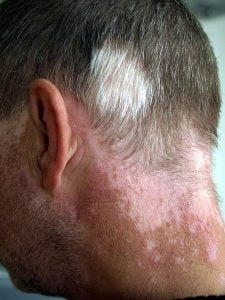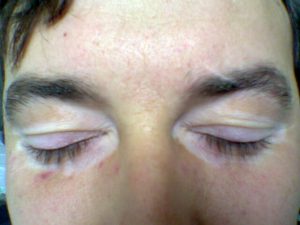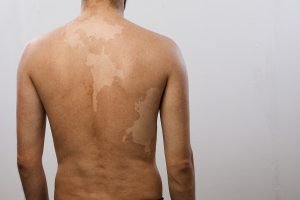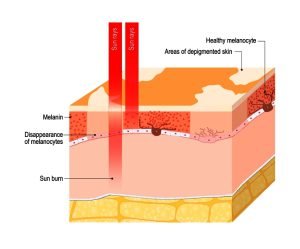Browsing: Vitiligo Graphics
Comprehensive Information, Resources, and Support on Vitiligo
The ultra-famous pop star, Michael Jackson, had vitiligo over some portions of his body.
Vitiligo is a disease that causes loss of skin color in patches. Vitiligo can affect any part of skin such as sun-exposed areas like the hands, feet, arms, and face, inside the mouth or other mucus membranes, nostrils, genitals, etc. Vitiligo occurs when pigment-producing cells (melanocytes) die or stop producing melanin. This may be due to some disorder in the immune system, family history (heredity), stress or exposure to industrial chemicals, etc. The extent and rate of color loss from vitiligo is unpredictable.
Another common location where vitiligo symptoms can occur is hands. White patches of depigmentation (as shown in the image) occurs on the skin of hands.
Some may experience the discoloration in the skin of the head and neck and in hair. A section of hair can turn white as shown in the picture. (Image author: Klaus D. Peter, Gummersbach, Germany)
Vitiligo can cause white patches to develop on your eyelids. But not all white skin patches around eyes are caused by vitiligo. (Image: Maria Sieglinda von Nudeldorf)
Vitiligo is a long-term skin problem that causes white patches of depigmentation to occur on certain sections of the skin including hands, face, and back. The most common sign of vitiligo is loss of pigments that produce milky-white patches (depigmentation) on the skin. No confirmed cure for vitiligo has been discovered yet.
The symptoms of vitiligo occur when the cells that are responsible for the skin color, melanocytes, are destroyed. The function of these cells is to produce skin pigment, called melanin, which is no longer available in the skin. This causes the areas of the skin to become de-pigmented and the skin loses its color or turns white. Initially, a small spot, called a macule, lighter in color than the skin around it develops which may grow into white patches and covers a large area of the body. Autoimmune disorders can be a suspected cause of vitiligo.
ADVERTISEMENT










